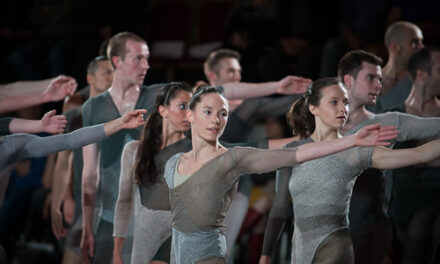The Giannini Brass is a brass quintet whose two trumpets are Anita Cirba and Kenneth Wilmot and whose French hornist is Joseph Mount. All three of these players are members of both the Winston-Salem and Greensboro Symphony Orchestras, and all have the North Carolina School of the Arts in their background. The trombonist is Chris Ferguson and the tubist is Brent Harvey. Percussionist John R. Beck of the North Carolina School of the Arts faculty assisted the quintet for this recital at the First Congregational Church in Hendersonville as part of Hendersonville Chamber Music.
Recitals by brass quintets tend to be divided into a first half focused on baroque music and a second half of contemporary pops music. Not this time. A single “Fanfare” by Henry Purcell was the only bow to the baroque era. No Gabrielli, no Corelli, no Albinoni. The first half, instead, was composed by Dmitri Kabalevsky, Aaron Copland, Leonard Bernstein, Morton Gould, and Gustav Holst; one Russian, three Americans and one Englishman, all twentieth-century composers.
The most profound works for the afternoon were excerpts from Bernstein’s West Side Story and from Holst’s Second Suite in F for Military Band. In the Bernstein, the two trumpet players doubled on flugelhorns to yield the soft romanticism required for the songs “Maria” and “Tonight.” The latter song was especially good as arranged for this ensemble. The countermelodies in trombone knit together with the trumpet and/or flugelhorn above the insistent rhythm of the percussion and tuba.
Three of the four movements of the Holst suite were played. This music, heavily indebted to English folk melodies, was originally composed for a classic British military band: 15 woodwinds, 13 brass players and percussion. As arranged for brass quintet, the three folk songs composing the “March” movement are soloed by trumpet, trombone and French horn, while the tuba keeps the martial beat moving. The “Song without Words” that follows stands in sharp contrast to the march. The fourth movement of the suite (third to be performed here) is a “Fantasy on Dargason” that Holst later arranged for the string orchestra of the girls’ school at which he taught. You may have heard it as the finale of the St. Paul’s Suite. It is a very clever molding of variations on the folk song “Dargason” with “Greensleeves” being added to form the climax. Despite the contrasting meter of 6/8 vs. 3/4, it works. This was the most complex work on the program.
Taking advantage of the presence of John R. Beck, the program included a xylophone solo with brass accompaniment. “Chasin’ Gary Dorn” is a virtuoso work that was played at a blistering tempo by the talented Mr. Beck. The son of the professor emeritus of percussion at Eastman School of Music, he is one of the finest percussionists in the country. He probably learned mallet technique at the breakfast table when he was in middle school.
The remainder of the program consisted of popular pieces: a Sousa march, a Dixieland riff, a Gershwin tune, a novelty tune for slide trombone (with the emphasis on slide) and a final group of songs from the Big Band era arranged for the brass. The overall programming appealed to the audience, but it was a pity that they were not given more of the profound works that are in the brass quintet repertoire. There was a little too much dessert, not enough main course.











